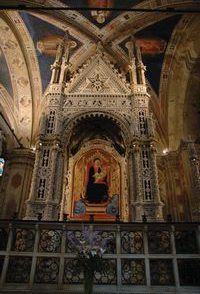One Tunisian cow
Six straw hats
Seven pounds of sausages
One illustrated book on the excellence of women
One short harquebus to go with the longer, more common models
A large basket of undersized asparagus (due to a poor summer in Milan)
Four live pheasants (in fact, three alive and one in critical condition)
Two lionesses plus maintenance manual from the Vatican
A cauliflower of most impressive size
A relic of Saint Cosmas of miraculous protective power
These are just a sample of the gifts that arrived in a never-ending stream at the Palazzo Vecchio for Duke Cosimo I de’ Medici. If his polite thank-you notes are to be believed, it would seem that even the humblest offering would be personally worn, used, or consumed by the grateful ruler of Tuscany. Having enjoyed, for example, the above-mentioned cauliflower, he requested that the donor send cauliflower seeds in the next ‘post’. His reactions to the undersized asparagus and salacious book are unfortunately unknown.
The range of gifts sent to Duke Cosimo I during his long reign reveal much about his personality and the value-system of his time. The primary reason for sending a gift was to initiate or maintain a good relationship. However, sending an important ruler the ‘wrong’ gift could be far worse than sending no gift at all.
If we were to paint a portrait of Cosimo I according to the gifts he received, we would see a warrior who enjoyed hunting and good food; a man who took pleasure in stocking his zoo with rare and exotic animals; a person who had a genuine interest in agricultural science.
One expensive set of gifts is particularly noteworthy, revealing as it does the motives of the donor as well as Cosimo’s interest in the latest weaponry. ‘I have sent to Your Excellency a pair of harquebuses and a boar spear with two small guns, and should they please you, I shall be most grateful’, writes Johann Fernberger von Aur from Felsberg on July 18, 1566.
Fernberger was a German officer who commanded the corps of mercenary soldiers who served as bodyguards for the ruling Medici family. The German Guard had been established in 1541—perhaps in imitation of the Pope’s Swiss Guard—and served the Grand Dukes of Florence for over two centuries.
Fernberger’s motive for sending the two matchlock guns as well as the rare and expensive ‘spiedo’ (boar spear) was to apologise for failing to return to Florence to resume his duties. He had been detained in his native country by the Holy Roman Emperor but wished to assure his master in Florence of his loyalty. He hoped to appease Cosimo by sending him a gift he thought an avid hunter would enjoy.
The boar spear is an example of the highly original handiwork by weapon constructors in the sixteenth century. A combination of ancient and modern technology, the beautifully crafted spear has two firearms on the flat portion of the blade, with the firing mechanisms placed behind the two wings, which prevented the blade itself from penetrating too far into the boar. According to military experts, the bullet-firing spear was also used on the battlefield against human quarry.
The cow, lionesses, cauliflower, asparagus, sausage, and pheasants, are, of course, long gone. You can, however, view the ‘spiedo’ in the armoury of the Museo del Bargello in Florence.
The translation of the letter from Fernberger and information on the boar spear was provided by research fellow Maurizio Arfaioli of the Medici Archive Project. The commentary was written by Mike Samuda.






